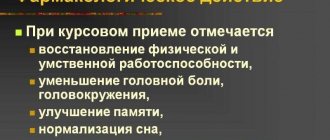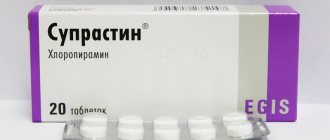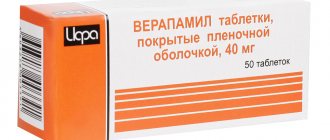Ethoxidol is a drug (tablets) that belongs to the category of drugs for the treatment of heart diseases. Important features from the instructions for use:
How to dissolve vascular plaques, normalize blood circulation, blood pressure and forget the way to the pharmacy
- Sold only with a doctor's prescription
- During pregnancy: contraindicated
- When breastfeeding: contraindicated
- In childhood: contraindicated
- For liver dysfunction: with caution
- If renal function is impaired: with caution
Release form and composition
Dosage forms of release of Ethoxidol:
- Chewable tablets: flat-cylindrical, scored and chamfered, white or white with a creamy tint, marbling, inclusions and slight surface roughness are acceptable (10 pcs each in contour strip packs, 1, 2 or 5 packs in a cardboard pack; 10 in polymer jars , 20 or 50 pcs., 1 jar in a cardboard pack);
- solution for IV (intravenous) and IM (intramuscular) administration: yellowish-brown or colorless (in glass ampoules of 2 or 5 ml, in a cardboard pack of 10 ampoules or 2 blisters of 5 ampoules each).
Composition of 1 tablet Ethoxidol:
- active substance: ethylmethylhydroxypyridine malate – 100 mg;
- auxiliary components: acetylglutamic acid – 68 mg; deanol – 32 mg; glycine – 20 mg; microcrystalline cellulose – 260.1 mg; povidone – 1.6 mg; lactose monohydrate – 36 mg; pregelatinized starch 30 mg; colloidal silicon dioxide – 9.5 mg; Magnesium stearate – 6 mg; croscarmellose sodium – 12.8 mg; sodium cyclamate – 18 mg; orange flavor – 6 mg.
Composition of 1 ml of Ethoxidol solution:
- active substance: ethylmethylhydroxypyridine malate – 50 mg;
- auxiliary components: acetylglutamic acid – 34 mg; deanol – 16 mg; glycine – 0.1 mg; edetate disodium – 0.5 mg; water for injection – up to 1 ml.
Price for tablets and ampoules
The price can vary greatly depending on the city of residence, and even more so on the pharmacy (despite the fact that the drug is included in the list of vital and essential drugs).
On average, the price of Mexidol varies within the following limits (price relevance as of 12/18/14):
- Tablets, package No. 30. 215-250 rubles.
- Tablets, package No. 50. 340-390 rubles.
- Injections 2 ml, package No. 10. 410-480 rubles.
- Injections 2 ml, package No. 50. 1750-2000 rubles.
- Injections 5 ml, package No. 5. 400-470 rubles.
- Injections 5 ml, package No. 20. 1380-1530 rubles.
Pharmacological properties
Pharmacodynamics
Ethoxidol is one of the inhibitors of free radical processes; has anxiolytic, anticonvulsant, antitoxic, membrane-protective, nootropic effects, increases the body's resistance to stress. Improves blood flow in the ischemic zone, has anti-ischemic properties, exhibits hypolipidemic effects, limits the area of ischemic damage, reduces the content of low-density lipoproteins and total cholesterol.
Ethoxidol increases the body's resistance to the effects of various damaging factors, to oxygen-dependent pathological conditions (ischemia and hypoxia, shock, cerebrovascular accidents, intoxication with antipsychotic drugs and alcohol).
Thanks to the use of the drug, cerebral metabolism, blood supply to the brain, rheological properties of blood and microcirculation are improved, platelet aggregation is reduced, and the membrane structures of blood cells (platelets and erythrocytes) are stabilized during hemolysis.
The mechanism of action of Ethoxidol is due to its antioxidant, membrane protective and antihypoxic effects. It reduces membrane viscosity, inhibits lipid peroxidation, increases membrane fluidity, superoxide oxidase activity and lipid-protein ratio. Modulates the activity of membrane-bound enzymes (adenylate cyclase, calcium-independent phosphodiesterase, acetylcholinesterase), receptor complexes, which leads to an increase in their ability to bind to ligands, improves synoptic transmission, transport of neurotransmitters, and preserves the structural and functional organization of biomembranes.
Pharmacokinetics
After oral administration, ethylmethylhydroxypyridine malate is completely and quickly absorbed from the gastrointestinal tract, the average rate is 0.569 ± 0.086 hours. After taking 100 mg of Ethoxidol, Cmax (maximum concentration of the substance) in the blood plasma is reached after 0.28 ± 0.08 hours and is 487 ± 72.4 ng/ml, after which the substance is quickly eliminated. T1/2 (half-life) is 1.46 ± 0.13 hours.
Ethoxidol is quickly distributed throughout the organs and tissues of the body. Within 7–10 hours it is determined in the blood plasma.
The drug undergoes intensive metabolism in the liver with the formation of phosphate-3-hydroxypyridine and glucurone-conjugated products.
After intramuscular administration, Ethoxidol is determined in the blood plasma for 4 hours. Cmax when administered 100 mg is in the range of 0.3–1.06 mcg/ml, the time to reach it is 0.25 hours.
From the bloodstream, ethylmethylhydroxypyridine malate quickly passes into tissues and organs and is quickly eliminated from the body. The retention time of Ethoxidol is from 1.84 to 2.38 hours.
T1/2 – 1.15–1.75 hours. The substance is excreted from the body by the kidneys, mainly in the form of glucuronides, unchanged - in small quantities.
The use of Mexidol for parkinsonism
Parkinsonism (Parkinson's disease) is a neurological pathology that is characterized by a progressive decrease in the amplitude and accuracy of movements, against the background of which tremor (shaking) of the limbs develops. Most often, the disease is diagnosed in older people (over 55 years old).
The morphological basis of the disease is associated with a violation of the synthesis of dopamine, a mediator of nerve impulses, in the substantia nigra of the brain. Standard treatment for pathology involves the use of replacement therapy with active precursors of the substance.
Long-term use of such drugs contributes to metabolic disorders in neurons, which is manifested by the synthesis of free radicals and damage to the cell membrane. An integrated approach using antihypoxic agents additionally affects peripheral structures and improves metabolism in the brain.
Clinical studies using Mexidol in the treatment of Parkinson's disease noted:
- increasing the speed of impulse transmission along the nerve (during a study on an electroneuromyograph);
- reducing the manifestations of tremor (oscillations) and increasing the amplitude of movements;
- increased efficiency and the possibility of reducing the dose of basic antiparkinsonian drugs (illustrated using the example of Cyclodol);
- reduction in the severity of symptoms (unsteadiness of gait, tremors in the hands, stiffness of movements) according to the Hen-Yahru scale;
- an increase in the concentration of dopamine metabolic products in the blood (results of an experimental study at the Center for Extrapyramidal Diseases).
As part of complex therapy, Mexidol is recommended for patients with Parkinson's disease at a dose of 200-400 mg/day in the form of a dropper (4-8 ml of a 5% solution of the drug per 250-300 ml of saline).
Indications for use
Chewable tablets
- coronary heart disease (simultaneously with other medications);
- ischemic stroke (simultaneously with other medications);
- mild to moderate cognitive impairment;
- encephalopathy.
Injection solution
- cerebrovascular accidents in acute course;
- encephalopathy;
- autonomic dystonia syndrome;
- anxiety disorders in neurosis-like/neurotic conditions;
- mild cognitive disorders of atherosclerotic origin;
- acute intoxication with antipsychotic drugs;
- withdrawal syndrome in alcoholism with a predominance of vegetative-vascular and neurosis-like disorders (relief).
Contraindications
Absolute:
- pregnancy and breastfeeding;
- age under 18 years;
- individual intolerance to any component of the drug.
Additionally for Ethoxidol chewable tablets:
- acute renal/liver failure;
- lactase deficiency, lactose intolerance, glucose-galactose malabsorption.
Ethoxidol injection solution in patients with a history of allergic diseases/reactions should be used under medical supervision.
Features of application at low pressure
The decrease in blood pressure when taking Mexidol is due to increased synthesis and accumulation of natriuretic peptide, which promotes the removal of sodium salts and water from the body (diuretic effect).
The moderate hypotensive effect of the drug requires careful use in patients with low levels of:
- at values of 110/70-90/60 – it is allowed to take a standard dose of Mexidol;
- less than 90/60 – consultation with a specialist is required about the advisability of prescribing the drug and the need for pressure correction.
For mild hypotension, Mexidol is recommended due to its ability to normalize the autonomic innervation of the vascular wall and increase indicators to optimal values.
Drug interactions: the drug enhances the effect of antihypertensive drugs (beta-blockers, diuretics), therefore it is prescribed with caution to patients with mild hypertension.
Instructions for use of Ethoxidol: method and dosage
Chewable tablets
Ethoxidol is taken orally. The tablets must be chewed and then washed down with water.
Recommended dosage regimen:
- complex therapy of coronary heart disease, therapy of ischemic stroke: 3 times a day, 1 tablet with a further increase in dose until effective. The maximum single dose is 2 tablets, the daily dose is 8 tablets. The duration of the course is at least 2 months, the doctor may prescribe a repeat course;
- complex therapy of cognitive disorders: 3-4 times a day, 1 tablet, duration of use has no restrictions.
Injection solution
Ethoxidol can be administered intramuscularly and intravenously (drip or stream).
The dose is determined individually. Therapy begins with 50–100 mg 1–3 times a day, gradually increasing the dose until it is effective.
Before infusion administration, the drug is diluted in a 0.9% sodium chloride solution.
IV jet Ethoxidol is administered slowly over 5–7 minutes, the drip rate is 40–60 drops/min.
The maximum daily dose is 800 mg.
Recommended dosage regimen:
- acute cerebrovascular accidents: in the first 2–4 days, 200–300 mg intravenously (drip), then 100 mg intramuscularly 3 times a day. Duration of use – from 10 to 14 days;
- dyscirculatory encephalopathy in the decompensation phase: intravenously (drip or stream) 2-3 times a day, 100 mg for 14 days, then intramuscularly, 2 times a day, 100 mg in the same course;
- course prophylaxis of dyscirculatory encephalopathy: 100 mg intramuscularly 2 times a day. Duration of use – from 10 to 14 days;
- mild cognitive impairment in elderly patients and anxiety disorders: IM 100–300 mg per day. Duration of use – from 14 to 30 days;
- alcohol withdrawal syndrome: 100–200 mg IM 2–3 times a day or IV drip 1–2 times a day for a course of 5 to 7 days;
- acute intoxication with antipsychotic drugs: iv 50–300 mg per day for a course of 7 to 14 days.
Reviews from people
Vera Lapteva
:
For us personally, Mexidol simply turned out to be a savior after a stroke. Firstly, speech returned, and secondly, a clear consciousness began to appear. I can only say positive things about this drug.
Olga Yanina
:
My close friend suffered a stroke.. This sight is not for the faint of heart... Rehabilitation took more than a year. Among other things, Mexidol was used as a restorative therapy - it seemed to me that the effect of the drug was good and my health improved - at least a visible effect. Although it is understandable, the initial condition of the patient and the attention of loved ones, their support and care are important.
Ekaterina Kostyuchenko
:
I completely agree with what was written above that Mexidol is indispensable in the treatment and rehabilitation after a stroke. It helped my aunt with the restoration of speech and reduction of hand tremors, and her memory became clearer. The main thing is to prescribe it in time, the sooner after a stroke, the more effective, before irreversible processes have time to develop. And of course, family support is of no small importance in rehabilitation; we did not leave my aunt alone for a minute.
Side effects
Chewable tablets
Ethoxidol is usually well tolerated. In rare cases, the following disorders may occur: allergic reactions, dyspepsia, nausea and xerostomia, diarrhea (usually disappear quickly on their own or after discontinuation of the drug).
During a long course, sleep disturbances (in the form of drowsiness or difficulty falling asleep) and flatulence may occur.
Injection solution
Possible disorders: metallic taste/dry mouth, unpleasant odor, feeling of spreading warmth throughout the body, feeling of lack of air, discomfort in the chest, sore throat (as a rule, these adverse reactions are short-term in nature and are associated with an excessively high rate of administration) .
During a long course, sleep disturbances (in the form of drowsiness or difficulty falling asleep), nausea and flatulence may occur.
Overdose
Chewable tablets
The development of an overdose is unlikely, which is due to the low toxicity of Ethoxidol.
Main symptoms: sleep disturbances (in the form of drowsiness, insomnia).
Symptomatic therapy is indicated.
Injection solution
Main symptoms: sleep disturbances (in the form of insomnia, sometimes drowsiness); with intravenous administration – a short (no more than 1.5–2 hours) and slight increase in blood pressure.
Symptoms of overdose, as a rule, disappear on their own within 24 hours and do not require therapy. In severe cases of insomnia, 10 mg of nitrazepam, 10 mg of oxazepam or 5 mg of diazepam are prescribed. If blood pressure is excessively increased, drugs with a hypotensive effect under blood pressure control are indicated.
Analogues and domestic substitutes
The domestic manufacturer offers patients many analogues - products that differ in name and cost: Mexiprim, Neurox, Astrox, Meksifin, Neurocard, Proinin.
Complex therapy in an inpatient clinic for neurological and cardiovascular diseases is accompanied by the use of antioxidants and other agents that improve metabolism.
The drugs most used in clinical practice are:
- nootropics (to improve cognitive abilities, accelerate metabolic processes in the brain): Piracetam, Pantogam, Bifren, Noofen, Cerebrolysin;
- “Actovegin” is a product made from dried calf blood extract, which increases tissue resistance to hypoxia, improves metabolic processes, and accelerates the healing of ulcers and wounds;
- "Mydocalm" is a drug used in neurology for the treatment of diseases with increased muscle tone (multiple sclerosis, parkinsonism), postoperative and traumatic contractures;
- "Meldonium" ("Mildronate") is a universal metabolic agent that is used in cardiology to restore the myocardium after a heart attack;
- vitamin preparations with antioxidant and neuroprotective effects: “Milgamma” (group B complex), “Aevit” (A+E).
Autonomic disorders caused by compression of nerve roots due to osteochondrosis require complex therapy:
- diuretics (“Furosemide”);
- nonsteroidal anti-inflammatory drugs (“Voltaren”, “Diclofenac”);
- muscle relaxants - to relax spastic back muscles (Mydocalm, Baclofen).
To relieve headaches, doctors recommend drugs with proven effectiveness - Spazmalgon, Ibuprofen.









